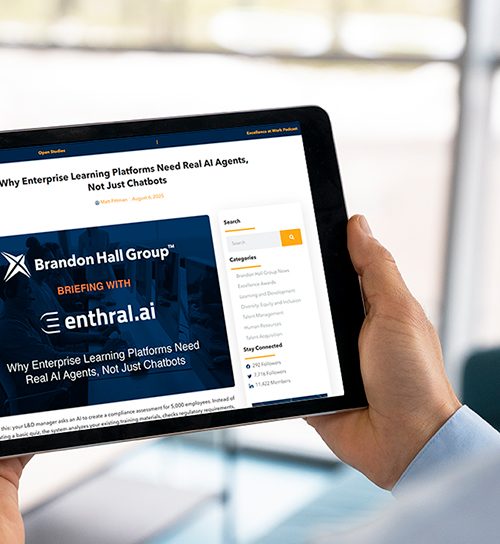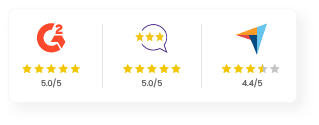11 Must-Have Features in an LMS for Extended Enterprise Training

In a modern world that is interconnected more than ever, no business can operate in silos. And that also means that learning and training programs can no longer be limited to only the employees and the internal workforce.
Instead, it’s all about creating a connected learning ecosystem that includes everyone the business works with. In fact, it’s now an imperative for businesses to extend their training programs beyond their internal teams to include external partners, customers, and suppliers. This approach, known as extended enterprise training, is transforming the way organizations manage learning and development.
But if this training isn’t managed and delivered properly, as a business, you risk having partners and customers who don’t perform well. This, needless to say, is very likely to impact your profits and your bottomline. Hence, the key is to pick a learning and training solution that’s a perfect fit for your extended enterprise training goals.
This is where an enterprise-grade Learning Management System (LMS) fits the bill.
In this blog, we look at some essential features to ensure your LMS supports effective extended enterprise training.
What is Extended Enterprise Training?
Extended enterprise training refers to training programs that are designed for audiences outside the core of an organization. This includes training for partners, customers, suppliers, or other external stakeholders.
Unlike traditional employee training, extended enterprise training aims to engage and educate those who interact with your company but are not part of the internal workforce.
Benefits of Extended Enterprise Training
Extended enterprise training offers several benefits that can seminally influence and impact your organization’s success:
Improved Partner Relationships
A well-trained partner becomes an extension of your sales team. Not just that, they also become ambassadors for your brand! By providing them with holistic training, you enable them to understand your product’s unique selling points, handle objections, and provide better customer service.
Increased Customer Satisfaction
When you provide your customers with well-designed training resources, you empower them to get the most out of your products or services. This leads to a more satisfying user experience and strengthens customer loyalty.
Training customers is not just about teaching them how to use your products. It goes beyond that to create a support system that helps them fully understand, appreciate, and use what you offer.
Spike in Sales
Your business partners and customers are powerful allies in boosting your sales. When you invest in extended enterprise training, you’re giving them a deep dive into your products or services, making them experts.
But the benefits don’t stop there. Happy customers/partners are more likely to spread the word about your product to friends and business contacts. Plus, they are likely to leave glowing reviews online, which not only boosts your ratings but also attracts high-quality leads and gives you a leg up over your competitors.
Better Brand Reputation
When your company is dedicated to providing high-quality training for external stakeholders, it demonstrates your commitment to exceptional support and service.
This commitment not only helps you stand out but also strengthens your brand’s reputation.
Key Extended Enterprise LMS Features to Look For
When selecting an LMS for extended enterprise training, there are several critical features to ensure the platform meets your needs and supports your training objectives.
1. Multi-Tenant Architecture
A multi-tenant architecture allows the LMS to support multiple, separate entities from a single LMS instance. Each tenant can have its own unique branding, user management, and content libraries so as to ensure a customized and efficient training experience for every entity.
This feature is essential for managing different brands or business units under one LMS while keeping their data and training content separate. This means you could have just 2 portals or 200, the LMS should let you easily scale up or down as you go along.
2. User and Role Management
An LMS with effective user and role management ensures you can easily assign and track various user roles and permissions across different tenants. This means the LMS supports multiple roles such as administrators, instructors, learners, and managers, giving each distinct permissions and access levels. This level of customization enhances relevance of the learning experience since it means tailored access to resources based on user roles.
3. Content Management
A robust content management system within the LMS allows for seamless creation, updating, and distribution of training materials. With this feature, the LMS allows to maintain a shared content library which has some common learning resources that can be accessed by multiple tenants.
Plus, it also offers specific training materials as per audience. For instance, partners may require product training modules, while customers might benefit from user guides and troubleshooting resources. This way, both general (available to all tenants) as well as specific training materials (based on tenant needs/relevance) are readily available.
4. Customizable Learning Environment
For extended enterprise training, it’s crucial to offer customizable learning environments tailored to different user groups. This feature allows you to create specific training paths for partners, customers, and suppliers based on their unique needs and roles.
The LMS should enable creating unique training portals for each group using a zero-code approach, which means administrators who have no coding knowledge can also easily manage all configurations and customizations through an intuitive interface. It should also allow for customizing the interface with the enterprise partner’s logos, color schemes, and multimedia banners, and create custom URLs that align with their brand (aka white labelling). The LMS should let you manage features and permissions with ease to ensure the best training experience for everyone.
5. Scalability
A robust LMS should be able to handle a diverse range of users across different tenants from different organizations and regions. Look for a platform that offers scalable solutions, capable of supporting both small groups and large-scale deployments without performance issues. For example, the LMS should be able to manage any number of external users—whether it’s a tenant with 100 users or another with 100,000—ensuring smooth operation and performance regardless of user volume.
6. Advanced Reporting and Analytics
To effectively manage extended enterprise training programs, you need great reporting and analytics tools. These help you track your external stakeholders’ real-time performance and gain valuable insights into their progress.
You can also easily identify strengths and areas for improvement, assess the effectiveness of your content and strategies, and make data-backed decisions to enhance the overall training experience.
7. Integration Capabilities
The LMS should seamlessly integrate with the tech stack and other systems and tools used within your organization and by your external partners. It should have integration capabilities with Customer Relationship Management (CRM) systems, HR platforms, communication tools and other business applications.
For instance, an LMS that integrates with a CRM system can automatically sync user data and track interactions for more cohesive training management.
8. Mobile Accessibility
Given the diverse locations and schedules of external learners, mobile accessibility is a must-have feature. The LMS should be optimized for mobile devices, allowing users to access training materials anytime, anywhere. This means that partners or customers are able to complete training modules with flexibility on their smartphones or tablets as per their convenience and pace.
9. Secure and Compliant
Ensuring that your LMS is secure and compliant with relevant regulations is crucial for protecting user data and maintaining trust. The LMS should offer features that support data encryption, user privacy, access and permissions and compliance with industry standards.
10. Multi-Language Support
For a global learner audience that is based in different geographies, support for multiple languages is essential. The LMS should offer multilingual capabilities to deliver training content and support in different languages. This ensures that the external partners can take their training in a language they are most comfortable with, in turn, improving the training experience.
11. User-friendly Interface and Learner Support
Finally, the LMS should have a user-friendly interface so that all external users can navigate it easily. The platform should be intuitive and accessible, minimizing the learning curve for new users.
It should offer features that create an engaging learning experience to support learners in their journey. Look for tools that support interactive content, gamification, and social learning to keep learners motivated and involved. For instance, features like interactive quizzes, gamified challenges, and discussion forums can enhance the learning experience for external users.
Key Takeaways
Extended enterprise training is a powerful way to extend your organization’s reach and impact. By picking an LMS with these key features, you can ensure that your training programs are effective, scalable, and capable of meeting the diverse needs of your external stakeholders.
Choose a feature-rich, enterprise-grade LMS like Enthral that offers the right blend of scalability, flexibility and engaging learning experiences to achieve your extended enterprise training goals and drive long-term success.

Train Your External Stakeholders
- Partner Enablement
- Customer Education
- Franchisee Training











